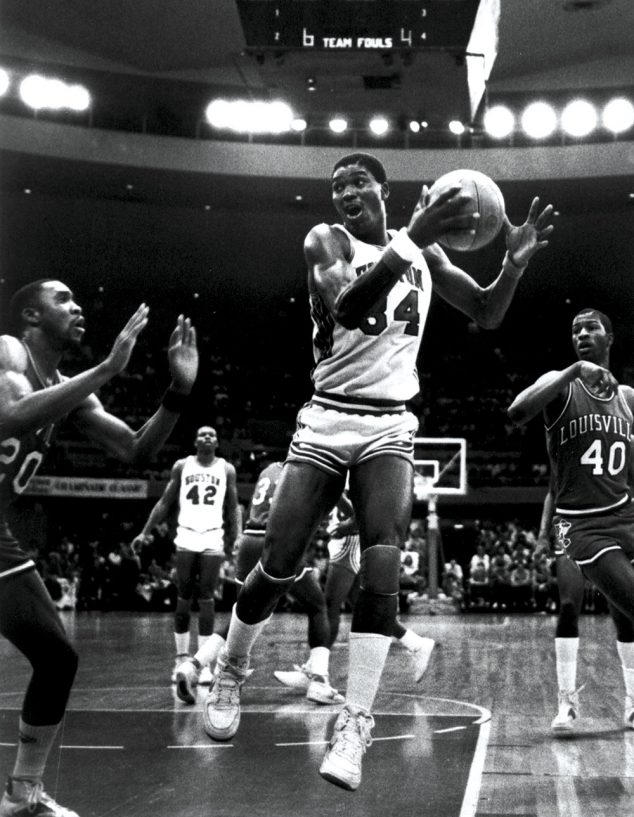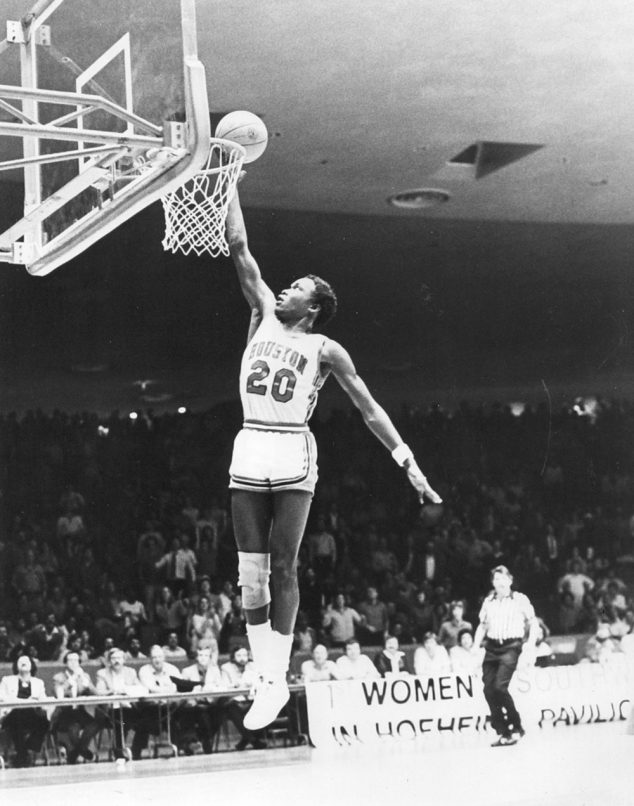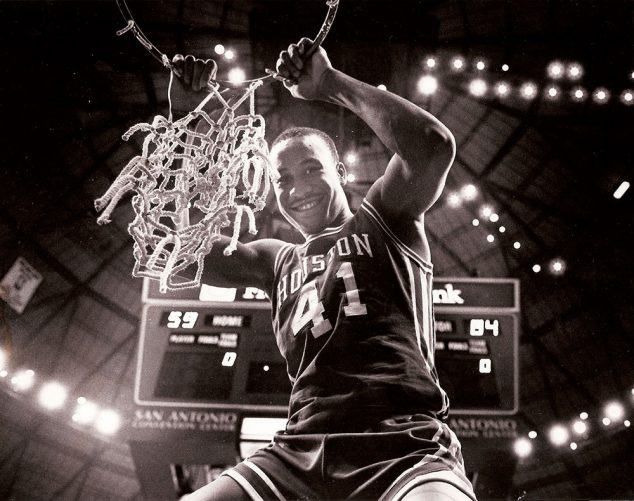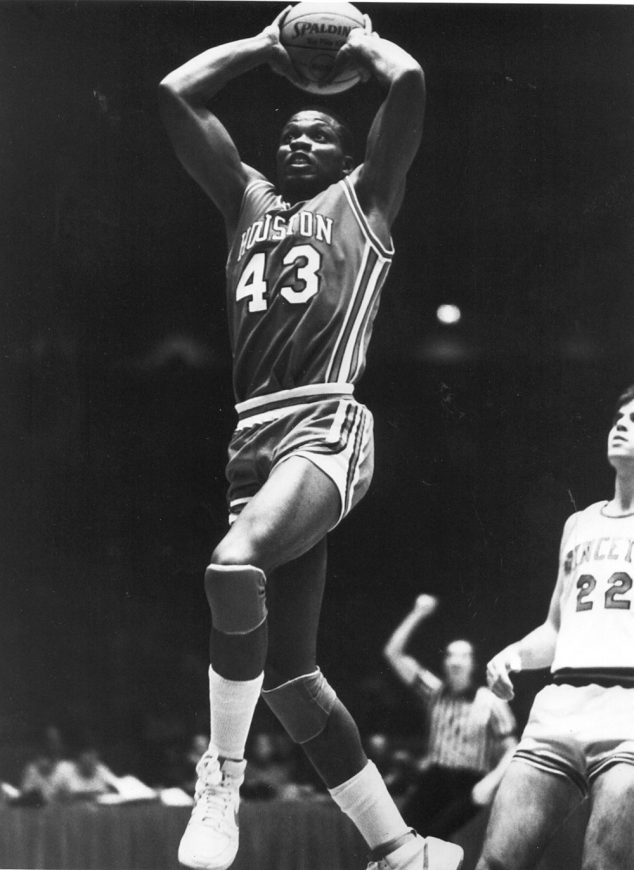With any sports team of historical significance, there’s always a specific moment when everything falls into place and begins to make perfect sense.
For the much-ballyhooed, air-walkin’, slam-dunkin’ University of Houston men’s basketball team, which was led by future Hall of Famers Hakeem “The Dream” Olajuwon and Clyde “The Glide” Drexler, that serendipitous moment came when a certain sportswriter turned in his column about a cadre of high flyin’ dunkers who used Hofheinz Pavilion as their launching pad. They were the thundering herd, barreling and fast breaking toward the basket, racking up 58 dunks during the infancy of the 1982-83 season.
“I was intrigued by the University of Houston team because they were so much fun,” says former Houston Post sportswriter Thomas Bonk. “They started playing above the rim and dunking everywhere, so I was trying to think, what would a college dunking fraternity be called? It had to have something with ‘Slam’ in it and most fraternities start with ‘Phi.’ I was on deadline and had to think of something: Phi Slama Jama. It was an innocent line in a column. And it immediately went viral before things even went viral. Everybody just embraced it. The players absolutely loved it because it gave them some notoriety.”
Of course Houston, a city known for interstellar flight, would spawn a team whose identity centered on its own brand of aerial artistry. The team, now dubbed Phi Slama Jama, dispatched 16 men who boldly bounced off the floor like a Spalding in search of rims to detonate. Vanity, as it turns out, is one helluva motivation to excel.
“To be in college and to come out with our own fraternity, Phi Slama Jama, was so cool,” says Olajuwon. “It was amazing just to have that name and concept and what made it even cooler was that you had to be on the team to be a member.”

Timing, of course, is everything. The Phi Slama Jama movement came on the heels of the dunkless era. From 1967 to 1976, the dunk shot was banned by the NCAA, a rule that came to be known as the “Lew Alcindor rule.” The rule was put in place to supposedly level the playing field, because players like Alcindor (now Kareem Abdul-Jabbar) and the extremely athletic men of the reigning champion Texas Western University were dominating the game because of their ability to “stuff” the ball into the basket once they got deep into the paint. The Zeitgeist was wrong, though, because the moratorium on dunks depleted the game’s excitement.
Everyone knew the bedazzling effectiveness of the dunk shot (the late great Chick Hearn coined the term “slam dunk,” a decidedly immense improvement over “dunk shot.” Thanks Chick!), but none more than Lewis, who encouraged his players to dunk outright because the dunk, of course, was meant to be a breathtaking spectacle and a devastating strategy against competitors.
“Dunking was something that was the highlight of any game,” says Olajuwon. “The opportunity to dunk in a game, that’s what the fans wanted to see.”
“Guy Lewis was a phenomenal coach and the reason he was such a good coach was he wanted us to shoot high-percentage shots,” says Drexler. “And what’s the highest percentage shot in the game? The dunk shot. So our focus was always on efficiency, and the dunk was a demonstrative shot that let the other team know you can’t stop us and if you can’t stop us, we gonna win this game. The dunk was significant for that reason. It was a highly efficient shot and it was an intimidating shot. So, the way we looked at it was, if we can get 15-20 dunks, you guys can’t guard us.”
Coach Lewis, a Hall of Fame hoops savant, was always interested in efficiency. He would always tell his players to “Do something with the ball positive—if you don’t do something with it positive, you’ll be sitting by me.” Armed with a new identity and full permission from their head coach to tattoo the rim, the Coogs put the rest of the NCAA on notice, making the quantum leap from regional dunking juggernaut to the biggest story in sports.
“These guys were showmen—they liked putting on a show, they loved being the center of attention. It’s what they did,” says Bonk. “They always said, ‘I like jump shots, but dunks are better.’ They thought it was perfect for them, gave them a real identity and [at] that time they were newcomers to the Southwest Conference, and some of the established teams didn’t care too much for them. The name gave them an edge. They appreciated it, they liked it.”
The fans liked it, too. When Texas’ tallest fraternity came to town, it was like they were the Beatles. Everyone wanted to see them play, even professionals. Earvin “Magic” Johnson, the sensational ringleader of the Los Angeles Lakers’ “Showtime” squad, was one of the team’s biggest fans.
“When you’re playing way above the rim, everybody in college basketball knows you,” says Drexler. “We were the No. 1 team in the country most of the year. When pro teams came to town, they would come to our practices. I distinctly remember seeing Greg Kelser—I think he was playing with the Pistons. He played with Magic and we grew up watching him and they’re in town to play the Rockets and he was at our practice that day. It was always stuff like that happening.”
“The recognition we got, the exposure, it was very unique,” says Olajuwon. “Phi Slama Jama was very catchy nationwide. With all the people coming to practice and coming to see us everywhere we went, it was like a rock-and-roll atmosphere.”

With the way the Houston Cougars stormed into the national sports culture, it’s hard to believe that most of them, Drexler and Olajuwon included, were not highly recruited prep stars coming out of high school. Most were virtual unknowns, except for Rob Williams, who led the team in scoring (21 ppg) during the 1981-82 season when the Coogs went to the first of three straight Final Fours.
“Rob Williams was the catalyst for Phi Slama Jama, if you ask me,” says Drexler. “He used to light up the pros while he was still in high school. He had the ball on a string. I went to UH to play with Rob and Larry Micheaux and I convinced Michael Young to go with me. We were all from the Houston area. After about a month, Hakeem came to the team from Nigeria. Once we started winning, we started getting the Mr. California, Mr. Indiana, Mr. Chicago—we had a deep and talented team, but the nucleus was the guys from Houston.”
The Cougars built their foundation in practice, where players went hard for three hours, running and scrimmaging nonstop. Any ball that was dunkable was dunked. Dunking was so fundamentally a part of the team’s identity that the players engaged in a light dunk contest before and after practices.
“We had incredible dunks because our practices were very intense,” says Drexler. “We had three-hour practices that were very intense and rarely a practice went by without two guys almost about to fight. That kind of intensity let Coach know we were ready to go. It got to the point where we would actually stage it where when everybody started to get tired, somebody had to pretend like they were about to get into a fight so Coach would think we were ready to compete.”
Olajuwon came off the bench during his first season because he was still very raw as a basketball player, but with his innate sense for protecting the paint, the Cougars were able to force their defensive will on opponents. They were most effective when they got out in the open court and ran. And boy did they run.

After losing to Ralph Sampson and the University of Virginia Cavaliers, the Coogs ran off 22 straight wins, garnering the No. 1 seed headed into March Madness. On their way to the Final Four, they made quick work of their first three opponents, Maryland, Memphis and Villanova.
Drexler finished his NBA career with 10 All-Star nods, spots on the All-NBA First-Team (1), All-NBA Second-Team (2) and All-NBA Third-Team (2), an NBA Championship with the Houston Rockets and an Olympic Gold medal with the 1992 Dream Team—but even now, after all he’s accomplished, everyone wants to talk about that Louisville game. The Doctors of Dunk (Louisville) vs Phi Slama Jama (Houston). It was televised and it was a riveting show for the ages.
For the first half, both teams were flipping the jab, feeling each other out. Louisville Coach Denny Crum’s wrecking crew held the Coogs to just two dunks and took a 41-36 lead into the half. It was more of the same in the second, with Rodney McCray helping the Cards extend their lead to 57-49. But then the UH frat boys unleashed the aerial assault with three slams in a row by Young, Drexler and Benny Anders to cut the lead to 57-55. From there, it was an onslaught, advantage Houston. With Crum employing a short bench and the effects of the elevation coming to bare, the Cards hit a wall. Drexler brought down the house with a hand-changing, double-pump Superman-over-a-locomotive dunk as part of a 58-point half, with the Coogs winning the game 94-81. When the smoke cleared, Drexler finished with 21 points, 7 rebounds and 6 assists, while prodigious shot-blocker Olajuwon stuffed the stat sheet with 8 swats, 21 points and 22 boards.
“That game was definitely the most exciting game of our time,” says Olajuwon. “We played freestyle basketball. Both teams were playing the same style, above the rim. It was a great game for all of us and the fans.”
After putting on an aeronautical show, the Cougars fell flat in the title game against NC State, a team that should have been easy fodder. The Wolfpack’s brand of slow ball made the Cougars look like a group of befuddled playground all-stars. Drexler got in foul trouble and Thurl Bailey scored 15 points in the first half, securing a 33-25 lead for the Wolfpack. Houston fought back at the start of the second, roaring off for a 17-2 run. But after pulling ahead 43-35, Coach Lewis elected to slow the pace and rest Olajuwon. Dereck Whittenburg hit two shots to even the score at 52 two minutes before the infamous Lorenzo Charles dunk at the buzzer that ended the Wolfpack’s Cinderella run with a title and Jim Valvano’s epic victory lap around The Pit.

For the Coogs, it meant another disappointing season. For Drexler in particular, though, it meant it was time to take his seismic tomahawk dunks to the NBA.
“When you lose a game like that, of course you want to win them, obviously, but if you don’t win, life goes on,” says Drexler. “Everybody can’t win every year but you give it your best shot and live with the results. I was OK with losing the game the day after it happened. If you play sports, you’re gonna lose some games. There are so few people that don’t lose, so you learn how to handle the losses with dignity, and you handle the wins with the same dignity. So the minute it’s over, it’s on to the next game. For me, it was about going to the NBA Draft and looking forward to realizing my dream of playing in the NBA. I tell Whittenburg every time I see him that they were better on that particular day and they deserved to win, right? And then I’ll say by the way, Dereck, great pro career. [Laughs] And he’ll be like, ‘Ooh, you ain’t have to go there.’”
Drexler took his tousled afro and ability to glide to the Portland Trail Blazers, but Houston made it all the way back to the title game the next year with Olajuwon dominating the lane with his Dream Shake. It was déjà vu, though, because Patrick Ewing’s Georgetown Hoyas felled the dunking fraternity 84-75. Phi Slama Jama U got full marks for making it back to the Big Dance, but for those keeping score, that’s 0-3 for one of the most exciting college teams to ever take the hardwood.
“We will go down as the best college team that didn’t win a title,” says Olajuwon. “We made it to three straight Final Fours, which is hard to do. But that’s the way it is in sports—you only have one chance in college. But playing with Phi Slama Jama gave me everything. It gave me the toughness and the confidence that every time I stepped on the court, you’re supposed to dominate. You need to dominate. It gave me the mentality to take over when I got to the NBA. I’m forever grateful for that.”
—
Photos courtesy of Houston Athletics